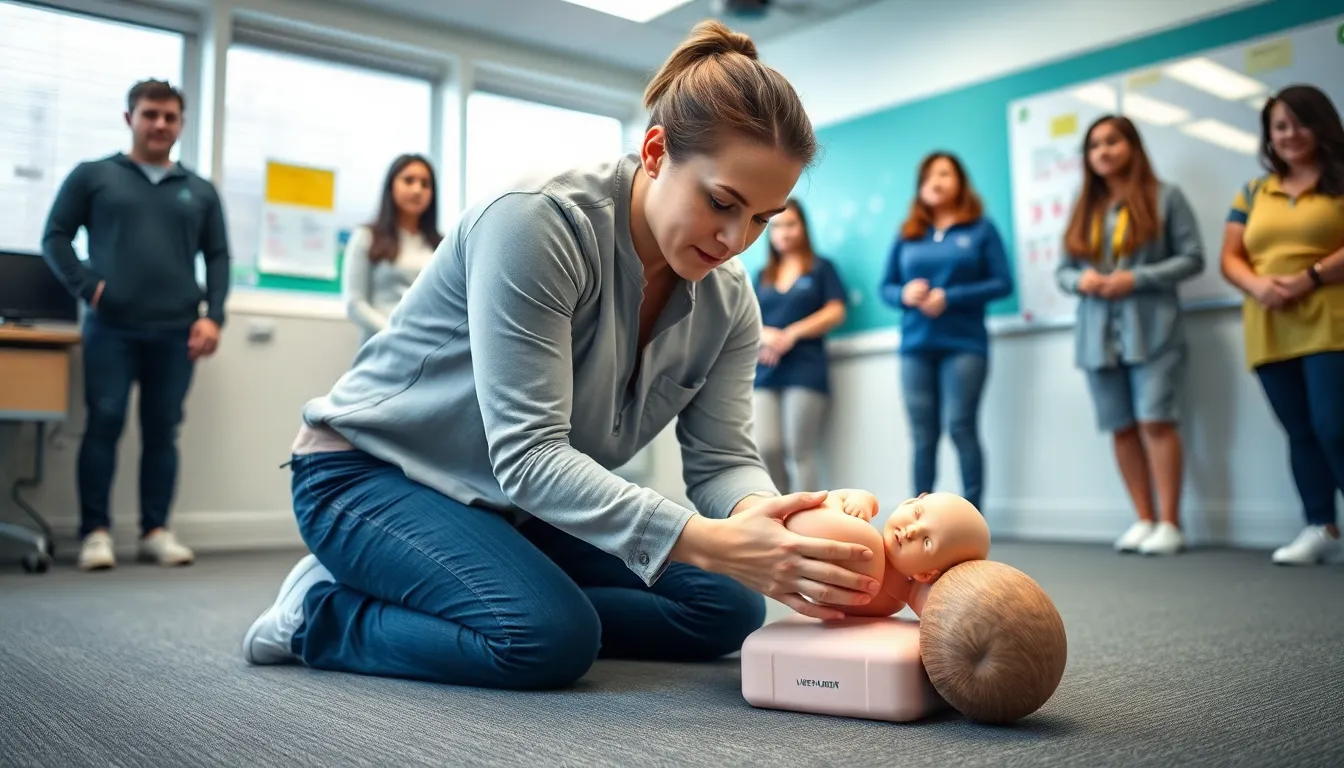When it comes to caring for infants, every parent knows that being prepared is key. But what happens when a tiny emergency strikes? That’s where infant CPR knowledge swoops in like a superhero in scrubs. Imagine being the calm in the storm, confidently handling a situation that could leave others frozen in fear. It’s not just a skill; it’s a lifeline.
Learning infant CPR isn’t just for the overzealous parent or the overly cautious grandparent. It’s for anyone who wants to be the hero of their little one’s story. With the right training, anyone can transform from a mere spectator to a life-saving champion. So, let’s dive into the essentials of infant CPR knowledge and discover how this vital skill can make a world of difference when it counts the most.
Table of Contents
ToggleImportance of Infant CPR Knowledge
Infant CPR knowledge holds vital significance in emergency situations involving infants. Immediate response can save a life when an infant suffers from cardiac arrest or stops breathing. Statistics show that up to 7,000 infants experience emergency situations annually in the United States, highlighting the need for trained caregivers.
Prepared caregivers can help minimize injury or fatalities during these critical events. Skills learned in infant CPR provide guardians with the ability to act decisively. Many parents can face the terrifying possibility of an emergency without the necessary preparedness.
Training in CPR, especially for infants, ensures that caregivers recognize signs of distress quickly. Understanding how to perform infant CPR correctly can empower individuals with confidence. Lifesaving techniques include chest compressions and rescue breaths tailored specifically for infants’ anatomy.
Certification courses are easily accessible, often provided by organizations such as the American Heart Association. Completing these courses equips caregivers with crucial knowledge and practical skills. As a result, trained individuals are more likely to respond effectively rather than freeze in panic.
Infant CPR knowledge fosters a safer environment for infants. Caregivers equipped with this training become proactive in emergency preparedness, enhancing overall safety in their communities. In any emergency, quick action can make the difference between life and death, and understanding infant CPR is an essential skill for every caregiver.
Basic Principles of Infant CPR

Understanding infant CPR basics provides caregivers with essential tools for emergency situations. Knowing how to recognize distress signals and perform lifesaving techniques makes a significant difference in critical moments.
Recognizing Cardiac Arrest in Infants
Infants may display several signs of cardiac arrest. Unresponsiveness is the primary indicator; they may not react to voice or touch. Breathing irregularities often accompany this condition; some infants may stop breathing entirely, while others may exhibit gasping or difficulty. Caregivers should also observe for color changes, such as blueness around the lips and face, indicating potentially severe oxygen deprivation. Immediate recognition of these signs is vital, as rapid response directly correlates with the infant’s chances of survival.
Steps to Perform Infant CPR
Performing infant CPR involves a series of specific steps. First, ensure the infant is on a firm, flat surface. Next, check responsiveness by tapping the foot gently while calling the infant’s name. If unresponsive, activate emergency services promptly. For infants, chest compressions begin by placing two fingers in the center of the chest, compressing down about 1.5 inches at a rate of 100 to 120 compressions per minute. After every 30 compressions, deliver two rescue breaths by creating a seal over the mouth and nose. Continue these cycles until emergency personnel arrive or the infant shows signs of responsiveness. Clear execution of these steps can significantly impact an infant’s survival in dire situations.
Training and Certification Options
Training in infant CPR provides essential skills and knowledge for caregivers. Many certification options exist to ensure proficiency in lifesaving techniques.
American Heart Association Guidelines
The American Heart Association (AHA) sets comprehensive guidelines for infant CPR training. These guidelines emphasize the importance of hands-on practice and effective teaching methods. AHA courses cover vital topics, including recognizing distress signals, performing chest compressions, and delivering rescue breaths. Caregivers certified through AHA programs receive updated information and techniques aligned with the latest research. These guidelines ensure that every participant can confidently respond to emergencies and significantly increase an infant’s chance of survival.
Online vs. In-Person Training
Choosing between online and in-person training presents options for caregivers. Online courses provide flexibility, allowing participants to learn at their own pace. They cover the fundamentals of infant CPR through videos and interactive modules. In-person training offers hands-on experience, which is crucial for mastering techniques. Engaging with instructors and practicing on mannequins enhances skill retention. Many caregivers prefer in-person sessions for the interactive learning atmosphere, while others appreciate the convenience of online platforms. Selecting the right format often depends on individual preferences and schedules.
Common Misconceptions About Infant CPR
Understanding infant CPR requires dispelling several misconceptions. Recognizing these misconceptions helps caregivers respond effectively in emergencies.
Distinguishing Between Infants and Children
Infants differ significantly from older children in terms of CPR techniques. Caregivers often mistakenly believe that CPR methods for older children are suitable for infants. Infants, typically defined as those under one year old, require gentler techniques. Chest compressions for infants involve two fingers placed just below the nipple line, while older children need a different approach. The airway management techniques also vary. An infant’s head should be kept in a neutral position to maintain airway patency, whereas older children can handle a slight tilt back. Understanding these distinctions significantly enhances the effectiveness of CPR and can be life-saving.
Myths Surrounding CPR Techniques
Many myths surround the execution of CPR, leading to confusion. One common myth suggests that performing CPR can cause harm to an infant. In reality, hesitating to perform CPR poses a greater risk. Another myth claims that breathing techniques are unnecessary; however, providing rescue breaths is vital for infants. Caregivers may also believe that they’ll perform CPR perfectly in a crisis. In actual emergencies, many feel overwhelmed; thus, training prepares caregivers for such situations. Dispel these myths to ensure effective responses during critical moments.
Resources for Parents and Caregivers
Accessing reliable resources enhances preparedness for infant CPR emergencies. Various options exist for parents and caregivers to expand their knowledge and skills.
Educational Materials and Videos
Numerous educational materials are available, including instructional videos tailored for infant CPR. Online platforms often feature content from reputable organizations like the American Heart Association. Caregivers benefit from visuals demonstrating proper techniques for chest compressions and rescue breaths. These resources make it easier to grasp complex concepts and practice at home. Comprehensive guides also discuss common distress signals, ensuring caregivers recognize critical signs quickly.
Community Classes and Workshops
Community classes and workshops provide invaluable hands-on experience in infant CPR training. Local hospitals, fire departments, and health organizations frequently offer these sessions. Participants engage in simulated exercises, practicing techniques on mannequins. In-person classes promote effective skill retention through direct interaction with certified instructors. Scheduling flexibility often accommodates various lifestyles, allowing caregivers to choose times that fit their routines. Classes enable caregivers to build confidence and competence while fostering a supportive learning environment.
Conclusion
Gaining knowledge in infant CPR is crucial for every caregiver. It not only equips them with lifesaving skills but also instills confidence during emergencies. The ability to recognize distress signals and act swiftly can truly make a difference in critical situations.
Accessing training resources and participating in courses can enhance a caregiver’s readiness to respond effectively. With the right preparation and understanding of CPR techniques tailored for infants, caregivers can play a vital role in safeguarding the lives of the youngest members of their families. Prioritizing infant CPR knowledge fosters a culture of safety and preparedness that benefits the entire community.








